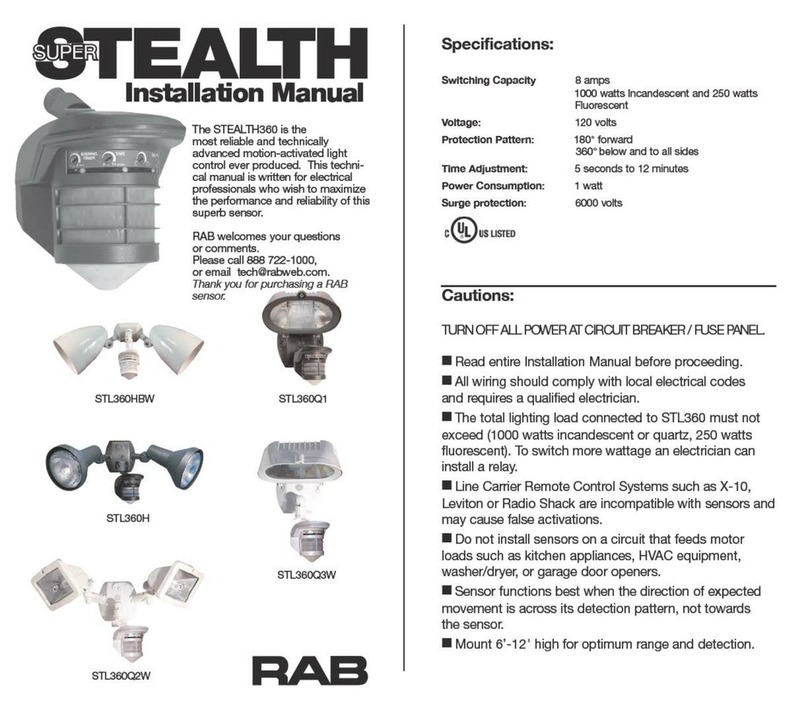
INSTRUCTIONS
STEALTH STL360 INSTALLATION
RAB Lighting is committed to creating high-quality, a ordable, well-designed and energy-e cient LED lighting and controls that make it easy for electricians to install
and
end
users
to
save
energy
.
We
’
d
love
to
hear
your
comments.
Please
call
the
Marketing
Depar
tment
at
888-RAB-1000
or
email:
[email protected]HOW DOES THE SUPER STEALTH 360 WORK?
HOW DO THE SCANNING LED DETECTION
INDICATORS WORK?
The STL360 infrared sensor“sees”temperature changes caused
by the motion of people or cars within its protection zone and
turns on lights automatically. It welcomes visitors and may
deter intruders.
Total coverage. Two sensors in one.
Two powerful detectors combine to give the STL360
“Can’t Miss” Detection: 180°long forward range (180° x 60’)
plus superb 360°detection below and to all sides.
IMPORTANT NOTES
SENSOR ADJUSTMENTS
Fig: 1
Fig: 2
Scanning LEDs serve as a deterrent by indicating a security device
in operation. They also show the STL360 mode of operation.
Automatic Mode
When the STL360 is “On Guard” in Auto Mode, three red LEDs scan
continuously day and night, except during detections (at which
time the controlled lights will go on and LEDs will be off)
as shown in Fig 1.
Test Mode
When the sensor is in “Test Mode” all of the LEDs will be o .
Manual Override Mode
When the sensor is ready for “Manual Override Mode” the
middle LED will be on steady.
Evening Timer Mode
When the sensor is ready for “Evening Timer Mode”
the middle LED will be blink.
How long do the lights stay on?
Lights remain on as long as there is movement within the
protection zone. Once the zone is vacated lights can be adjusted
to remain on approximately 5 seconds up to 12 minutes. Since the
lights are on only when needed, the sensor uses only one watt.
The Stealth is extremely energy e cient.
Can outdoor lights still be turned on with the light switch?
Yes. STL360 can be controlled by a conventional indoor switch or
circuit breaker. STL360 operates in the Auto Mode unless changed.
Lights can be turned on or o manually at night only with the
Manual Override Mode.
Wall Switch Manual Override (to keep lights on)
Flip the switch twice slowly (off-on-off-on) within 1–2 seconds.
If you set this during the day the sensor will enter Manual
Override Mode at dusk.
Evening Timer (to keep lights on, and is repeated every night)
Flip the switch three times slowly (off-on-off-on-off-on) within
1½ – 3 seconds. You can set this during the day and the
Evening Timer Mode will begin at dusk.
To Resume Automatic Mode
Switch power o for at least 10 seconds, then back on.
Will STL360 detect animals?
STL360 may detect large animals. Having animals trigger the
sensor can give property a “lived-in” look. However, you can
limit animal detection by turning down the sensitivity knob
and/or placing the blinders provided on the lower part of the
forward lens.
How do you make adjustments to the sensor?
Use the adjustment tool provided as shown in Fig 2, or a
screwdriver with a 1/8”wide blade to adjust the controls on the
front of the sensor (see next page).
“On Guard Auto Mode”LEDs scan
continuously back & forth
“Test Mode” all LEDs o
Middle LED on steady is Manual Override Mode
Middle LED blinking is Evening Timer Mode
TIME
1 8 HRS 5 SECS 12 MINS – +
EVENING
TIMER
SENS




























